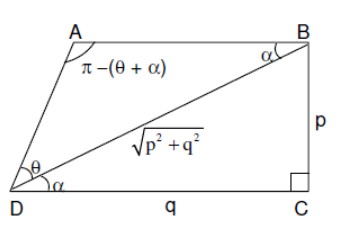
ABCD is a trapezium such that AB and CD are parallel and BC ⊥ CD. If ∠ADB=θ, BC=p and CD =q, then AB is equal to
A. $\dfrac{{{p^2} + {q^2}\cos \theta }}{{p\cos \theta + q\sin \theta }}$
B. $\dfrac{{{p^2} + {q^2}}}{{{p^2}\cos \theta + {q^2}\sin \theta }}$
C. \[\dfrac{{\left( {{p^2} + {q^2}} \right)\sin \theta }}{{{{\left( {p\cos \theta + q\sin \theta } \right)}^2}}}\]
D. \[\dfrac{{\left( {{p^2} + {q^2}} \right)\sin \theta }}{{\left( {p\cos \theta + q\sin \theta } \right)}}\]
Answer
575.1k+ views
Hint: In order to solve this question we need to draw the diagram and then apply the formula of trigonometry using cos and sin that is we need to know must the formula of $\cos \alpha = \dfrac{q}{{\sqrt {{p^2} + {q^2}} }} and \sin \alpha = \dfrac{p}{{\sqrt {{p^2} + {q^2}} }}$. Then we have to use sine formula to get the value of AB and then on solving we will get the right answer.
Complete step-by-step answer:

In the triangle BCD $\cos \alpha = \dfrac{q}{{\sqrt {{p^2} + {q^2}} }}and\sin \alpha = \dfrac{p}{{\sqrt {{p^2} + {q^2}} }}$
Using sine rule in triangle ABD we get the equation as,
\[\dfrac{{AB}}{{\sin \theta }} = \dfrac{{BD}}{{\sin \left( {\theta + \alpha } \right)}}\]
Then we get the value of AB as,
\[ \Rightarrow AB = \dfrac{{\sqrt {{p^2} + {q^2}} \sin \theta }}{{\sin \theta \cos \alpha + \cos \theta \sin \alpha }}\]
Then on putting the values obtained above of cos and sin we get the new equation as,
\[ \Rightarrow \dfrac{{\sqrt {{p^2} + {q^2}} \sin \theta }}{{\dfrac{{\sin \theta q}}{{\sqrt {{p^2} + {q^2}} }} + \dfrac{{\cos \theta p}}{{\sqrt {{p^2} + {q^2}} }}}}\]
After solving it further we get the value of AB as:
\[ \Rightarrow AB = \dfrac{{\left( {{p^2} + {q^2}} \right)\sin \theta }}{{\left( {p\cos \theta + q\sin \theta } \right)}}\]
Note: A trapezium is a quadrilateral with two parallel sides. The parallel sides of a trapezium are called bases and the non-parallel sides of a trapezium are called legs. It is also called a trapezoid. Sometimes the parallelogram is also called a trapezoid with two parallel sides.
Complete step-by-step answer:

In the triangle BCD $\cos \alpha = \dfrac{q}{{\sqrt {{p^2} + {q^2}} }}and\sin \alpha = \dfrac{p}{{\sqrt {{p^2} + {q^2}} }}$
Using sine rule in triangle ABD we get the equation as,
\[\dfrac{{AB}}{{\sin \theta }} = \dfrac{{BD}}{{\sin \left( {\theta + \alpha } \right)}}\]
Then we get the value of AB as,
\[ \Rightarrow AB = \dfrac{{\sqrt {{p^2} + {q^2}} \sin \theta }}{{\sin \theta \cos \alpha + \cos \theta \sin \alpha }}\]
Then on putting the values obtained above of cos and sin we get the new equation as,
\[ \Rightarrow \dfrac{{\sqrt {{p^2} + {q^2}} \sin \theta }}{{\dfrac{{\sin \theta q}}{{\sqrt {{p^2} + {q^2}} }} + \dfrac{{\cos \theta p}}{{\sqrt {{p^2} + {q^2}} }}}}\]
After solving it further we get the value of AB as:
\[ \Rightarrow AB = \dfrac{{\left( {{p^2} + {q^2}} \right)\sin \theta }}{{\left( {p\cos \theta + q\sin \theta } \right)}}\]
Note: A trapezium is a quadrilateral with two parallel sides. The parallel sides of a trapezium are called bases and the non-parallel sides of a trapezium are called legs. It is also called a trapezoid. Sometimes the parallelogram is also called a trapezoid with two parallel sides.
Recently Updated Pages
Why are manures considered better than fertilizers class 11 biology CBSE

Find the coordinates of the midpoint of the line segment class 11 maths CBSE

Distinguish between static friction limiting friction class 11 physics CBSE

The Chairman of the constituent Assembly was A Jawaharlal class 11 social science CBSE

The first National Commission on Labour NCL submitted class 11 social science CBSE

Number of all subshell of n + l 7 is A 4 B 5 C 6 D class 11 chemistry CBSE

Trending doubts
What is meant by exothermic and endothermic reactions class 11 chemistry CBSE

10 examples of friction in our daily life

One Metric ton is equal to kg A 10000 B 1000 C 100 class 11 physics CBSE

1 Quintal is equal to a 110 kg b 10 kg c 100kg d 1000 class 11 physics CBSE

Difference Between Prokaryotic Cells and Eukaryotic Cells

What are Quantum numbers Explain the quantum number class 11 chemistry CBSE




